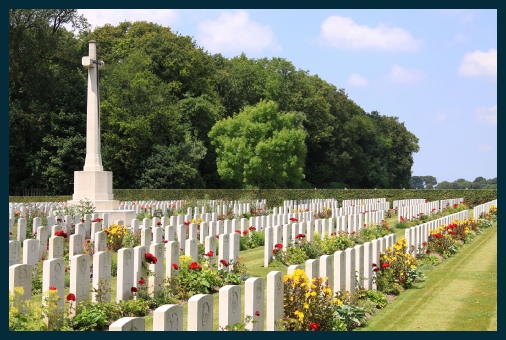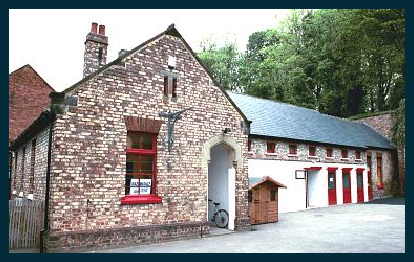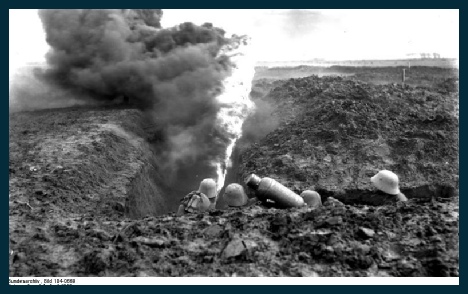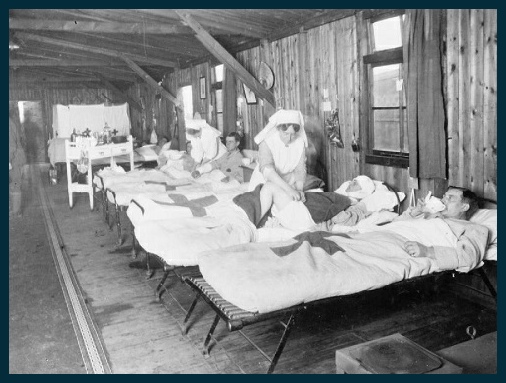Copyright © All rights reserved.



John Nicholson

In mid-
Westvleteren was outside the front held by Commonwealth forces in Belgium during the First World War, but in July 1917, in readiness for the forthcoming offensive, groups of casualty clearing stations were placed at three positions called by the troops Mendinghem, Dozinghem and Bandaghem. The 4th, 47th and 61st Casualty Clearing Stations were posted at Dozinghem and the military cemetery was used by them until early in 1918.
John seems to have enlisted in the 7th (Service) Battalion of the Yorkshire Regiment on 14th November 1914 in Pickering, shortly after the Battalion was raised in September.
After training in England they finally embarked for France on 13th July 1915 from Folkestone, arriving the next day and arriving by train at Remielly-
By August they had come under heavy fire and were regularly coming under sniper fire. Notes in the War Diary read: “Time in the trenches occupied in strengthening the parapets and digging new shelter trenches. Great difficulty was experienced in digging everywhere owing to the number of corpses which had been buried where the trenches were. … Half the battalion had baths in the Brewery at Reninghels where hot showers were fitted up and a change of underclothing provided. … An accident occurred during practice in bomb-
Throughout September and October life continued to be routine with the occasional bombardment, and regular withdrawal from the trenches for rest and training. At the end of October the Battalion was moved to Ypres, two companies taking over the trenches and tunnels in the rampart of the town. The war diary sums up November: “Nothing unusual during this tour of duty. Much artillery and aeroplane activity but very few casualties and little damage to trenches.”
December continued with an escalation both of bombardment and of gas attacks at Ypres, and at the end of the month they moved back into trenches before moving to rest billets at Polincove where they spent most of January. At the beginning of February they took over billets at Dickiebusch where they came under heavy attack as they prepared to move into trenches, sustaining some 50 casualties. The trenches to which they were moved were considerably sub-
Toward the end of March the Battalion moved to billets in Armentieres before moving to trenches at Pont Ballot – far better conditions than in the Ypres Salient. April and May saw them rotating trench life with rest periods and training in a fairly uneventful time. In mid – June they moved to trenches south of Fricourt where they incurred casualties from “canister bombs” – oil drums filled with explosive which inflicted extensive structural damage as well as deaths. In late June and early July they took part in the attack on Fricourt , which while ultimately successful left the Battalion with about 350 casualties The following weeks were spent in horrendous conditions in trenches around Mametz Wood participating inabortive attacks on the German forces, which resulted in another 104 casualties. Over the three weeks the Battalion had dwindled from a fighting strength of 890 to a fighting strength of 430. Over the next week a small number officers and men were drafted in and trained, and training and the arrival of fresh recruits continued during the first half of August, before returning to trenches at Hebuterne, where much of their time was spent improving the trenches against the winter and the construction of deep dugouts. October seems to have been spent in apparently aimless marching interspersed with training and salvaging materials and abandoned weaponry for re-
In November they moved into trenches near Lesbouefs and spent the next week in heavy but inconclusive fighting during which they sustained over 100 casualties. “The condition of the trenches, which, in many places, were from 3’ to 4’ deep in water and mud, and the lack of any shelter whatever, caused much sickness in the nature of trench feet among the men.” Through most of December they were in camp training as part of Brigade Reserve but returned to the trenches at Sailly-
John William Nicholson was born in the second quarter of 1894 and his birth registered in Malton. He was the oldest son of John Thomas and Jane Anne (nee Yates) Nicholson who married in New Malton on 7th January 1894, after the birth of their daughter Lily. His father died in the second quarter of 1900 aged 37 and by the next year the family were all in Malton Workhouse where his mother was a patient.
1901 Census – resident at Union Workhouse, Malton
NICHOLSON, Jane, Patient, Widow, F, 38, , Thirsk Yorkshire,
YATES, Lillian, Inmate, Single, F, 8, , Kirby Yorkshire,
NICHOLSON, John Thomas, Inmate, Single, M, 7, , Norton Yorkshire,
NICHOLSON, Jane Elizabeth, Inmate, Single, F, 5, , Norton Yorkshire,
NICHOLSON, Mary, Inmate, Single, F, 1, , Norton Yorkshire,
While we know that Jane and her youngest daughter Alice Mary were still in the workhouse in 1911 and Lillian Yates had gone into domestic service in Hovingham, John seems to have eluded the census enumerators. This , coupled with the fact that the WW1 Service Medal Roll states that before joining the 7th Yorkshires he served in the 2nd Yorkshires suggests that he had probably signed up for service in the Yorkshire Regiment as a Regular by 1911.


They were back in action again in April at Arras with a further 120 casualties. May saw more training until 9th May when they moved into trenches at Roeux and were almost at once involved in incessant fighting sustaining more heavy casualties. In a week they were reduced from 18 officers and 436 other ranks to 5 officers and 241 O.R. with only one Company officer remaining of 14. As a result of this action Pte. Tom Dresser was awarded the Victoria Cross. After a few days re-
